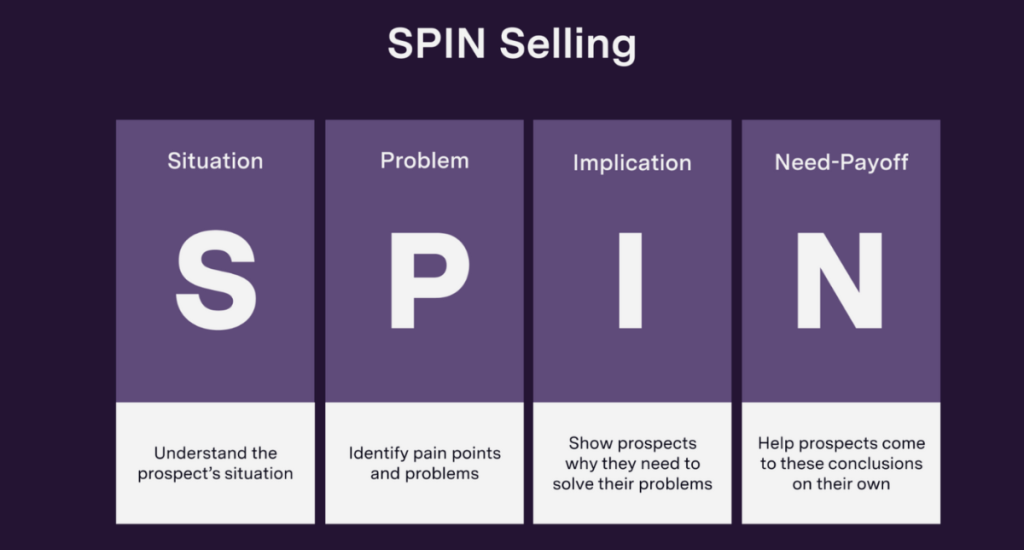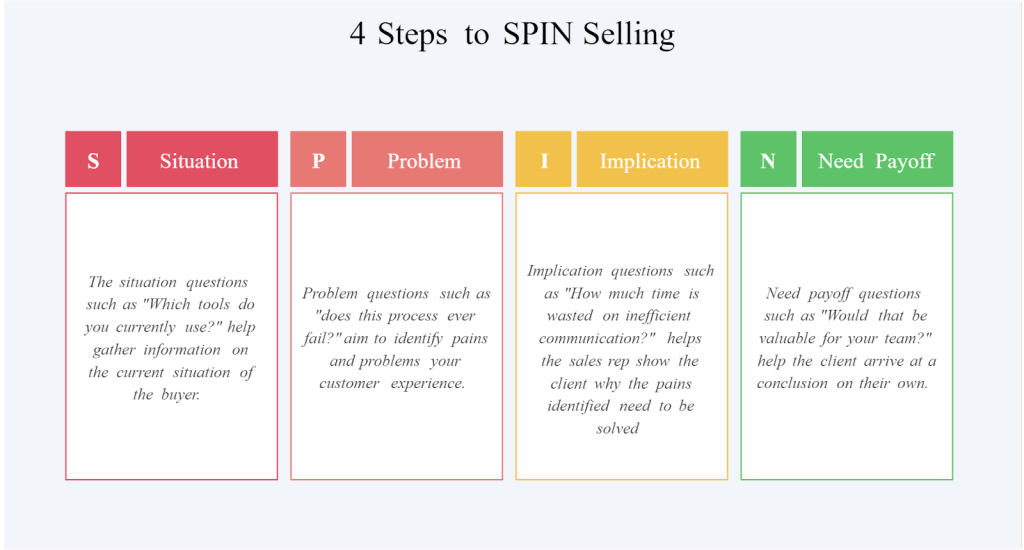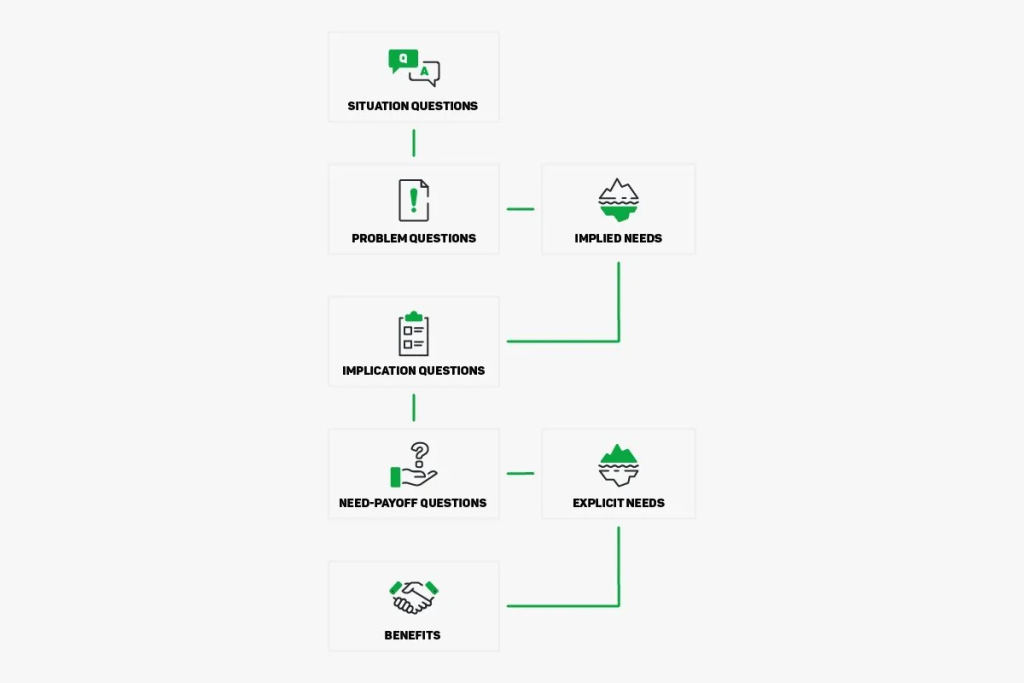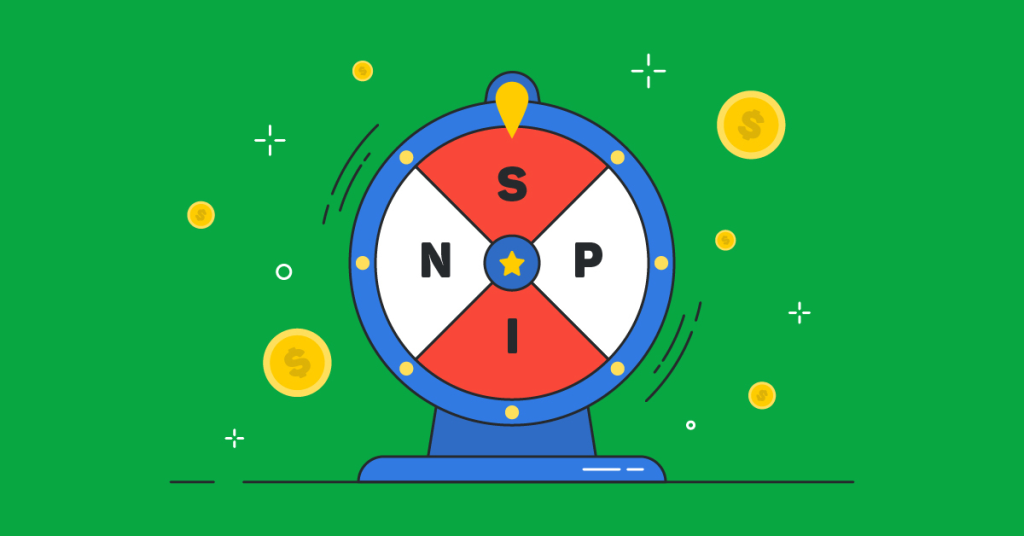SPIN Sales Training is a proven methodology that helps sales professionals effectively uncover and address their customers needs and pain points. There are various methods through which a seller sells a product or service. Each technique is unique and applies in a certain context. One of the most effective sales techniques that you may need to apply in many situations is Spin Selling. This way you will be able to reap all the benefits that this technique offers.
However, let’s first understand the basics about Spin Selling through this post.
Understand Spin Selling

Spin Selling Technique is based on the book named ‘SPIN Selling’.
The book is written by Neil Rackham and is available at: SPIN-selling By Neil Rackham
It was published in 1988.
Though, this technique is still practical and works in modern scenarios.
The main aim of this sales technique is to assist the sales reps in understanding and navigating in difficult sales situations.
Thus, SPIN stands for:
- Situation
- Problem
- Implication
- Need-Payoff
SPIN Selling in Simple Words!
In simple words, SPIN selling technique involves a sequence and type of questions to be asked to customers in a specific order.
Each question type will play a crucial function in the sales process.
Let’s understand the SPIN Selling questions in detail.
FOUR Key Components to SPIN Selling in Detail

Situation Questions
Most sales reps make a common mistake.
It is entering into pitching.
It is important to note that as a sales rep, you have to sell the product but to the right customer and at the right price.
However, if you push selling and force prospects to buy without understanding their situation, you will only damage your brand’s image.
Hence, as per the Spin Sales Training, the first questions that you must ask to your prospective clients must be about understanding their situation.
This will help you evaluate whether your product or service is their need or which product will help them and much more.
For example, Situation Questions can include:
- What are they working on?
- What tools are they using?
- How do they aim to improve their business processes?
Problem Questions
Selling means problem-solving by offering products or services.
Thus, problem Questions are important and here you need to understand the problems of your prospective clients.
You do not need to promote your product.
Rather, you should be aware of the problems that your prospects are facing.
Or even better, you must educate them about the problems which may arise in the future and how to prevent them.
Problem Questions should only be asked if you understand the client’s situation through situation questions.
Otherwise, you will unnecessarily waste their time and yours as well.
Furthermore, without understanding the situation and trying to understand their problems will reflect poor communication skills.
Hence, communication skills as taught in sales training should be clearly understood.
The examples of problem questions may include:
- How difficult is this process?
- How do you think you can prepare for it?
- Do you think this will be completely the right thing to do and do you have any backup plan?
Implication Questions
After understanding the situation and problems of your target audience, you need to create a sense of urgency.
Because, the targeted clients may view the problem as minor and not understand the effects.
Here, you need to educate them and keep in mind you do not need to still mention your product.
The reason is if you clearly show them that you genuinely care about them and are not only interested in selling then they will be interested to hear about your product.
Some of the Implication questions in Spin Sales Training may include:
- What is the weekly time spent on ineffective communication?
- What could your teams accomplish in a week without these time-wasting activities?
- Have there been instances where communication issues have caused delays in product launches?
Need-Payoff Questions
The last stage of questions in Spin Sales Technique is Need-Payoff questions.
Important thing here again is not to mention your product or promote it directly.
Rather your approach should be of again asking questions.
Once you have reached this stage, the prospective customer already understands that there is a problem and it’s urgent to solve it.
However, with a little brainstorming, they will also be able to land a solution which will be your product or service.
Nonetheless, it’s your job that they choose your product or service and not your competitors.
Having found out the solution themselves will help you close the deal quickly as there will be a sense of happiness for the client.
Need Pay-off questions may include:
- Could the implementation of a comprehensive product management tool enhance stakeholder support?
- Would this tool be beneficial for your team?
- What is the significance of being able to perform X for your organization?
Important thing to keep in mind for Spin Sales Training and Spin Sales Technique

Spin Sales Technique is complex and takes time to learn.
Do you think your sales reps with different education backgrounds and opinions will be able to understand it so easily?
Do you think there won’t be any resistance?
However, if you don’t teach them do you think they will be able to protect the brand image?
Hence, sales training programs providing Spin Sales Training must be implemented.
Furthermore, One sided communication is what kills sales.
Spin Sales Technique is the exact opposite to one sided communication skills.
It is not rigid.
Spin Sales Technique is flexible and the best sales reps consistently use these questions.
Benefits of Spin Sales Training Technique

Increased Sales
The Spin Sales Technique focuses on understanding the customer’s needs and preferences.
By doing this, the salesperson can tailor their pitch to match the customer’s needs, which increases the likelihood of a successful sale.
When customers feel that their needs are being met, they are more likely to make a purchase.
Improved Customer Relationships
By using the Spin Sales Technique, salespeople can build better relationships with their customers.
This is because the technique focuses on understanding the customer’s needs and preferences, which helps to create a more personalized experience.
When customers feel that their needs are being understood and met, they are more likely to return to the business in the future.
Better Understanding of Customer Needs
The Spin Sales Technique is designed to help salespeople understand the customer’s needs better.
By asking specific types of questions, the salesperson can uncover the customer’s pain points and desires.
This information can then be used to create a tailored pitch that meets the customer’s needs.
By understanding the customer’s needs, salespeople can also identify upselling and cross-selling opportunities.
More Efficient Sales Process
The Spin Sales Technique is designed to make the sales process more efficient.
By understanding the customer’s needs upfront, the salesperson can create a tailored pitch that is more likely to be successful.
This saves time and resources that would otherwise be spent on ineffective pitches.
Improved Confidence
By using the Spin Sales Technique, salespeople can improve their confidence.
This is because the technique is based on a structured approach that helps salespeople to better understand their customers.
This understanding can help salespeople feel more prepared and confident when approaching potential customers.
Increased Revenue
By using the Spin Sales Technique, salespeople can increase revenue.
This is because the technique is designed to uncover upselling and cross-selling opportunities.
By understanding the customer’s needs and preferences, salespeople can identify additional products or services that the customer may be interested in purchasing.
Better Sales Forecasting
The Spin Sales Technique can help businesses to improve their sales forecasting.
By understanding the customer’s needs and preferences, salespeople can identify the likelihood of a sale.
This information can then be used to create more accurate sales forecasts.
Competitive Advantage
The Spin Sales Technique can provide businesses with a competitive advantage.
By using a structured approach to sales, businesses can differentiate themselves from competitors.
This can be particularly effective in industries where customers have a wide range of options.
Benefits of Spin Sales Training

Increased Sales Productivity
Spin Sales Training is designed to help your sales team become more efficient in their sales efforts.
By teaching your team how to ask the right questions, they can qualify leads more effectively and close deals more quickly.
As a result, your team’s productivity will increase, and they will be able to generate more revenue for your business.
Improved Sales Techniques
Spin Sales Training teaches your sales team a proven methodology that has been used successfully by thousands of salespeople worldwide.
By understanding the SPIN model (Situation, Problem, Implication, and Need-Payoff), your team will be better equipped to handle objections, build rapport with customers, and close more deals.
Better Customer Understanding
By asking the right questions, your sales team will gain a deeper understanding of your customers’ needs and pain points.
This knowledge will help your team to provide tailored solutions that meet your customers’ unique needs.
As a result, your team will be better equipped to build long-term relationships with your customers, which will lead to more sales and revenue over time.
Increased Confidence
Spin Sales Training helps your sales team to become more confident in their abilities.
By learning a proven methodology and practicing it regularly, your team will become more comfortable with the sales process, which will lead to increased confidence when engaging with customers.
As a result, your team will be more effective in their sales efforts, leading to increased revenue for your business.
Better Time Management
Spin Sales Training helps your sales team to become more efficient with their time.
By focusing on the most important aspects of the sales process, your team will be able to prioritise their efforts and avoid wasting time on activities that do not generate results.
As a result, your team will be more productive, and you will see a positive impact on your business’s bottom line.
Enhanced Sales Team Collaboration
Spin Sales Training encourages teamwork and collaboration among your sales team members.
By practicing the SPIN model together and sharing best practices, your team will become more cohesive and work together more effectively.
This collaboration will lead to better results and increased revenue for your business.
Better Sales Forecasting
By using the SPIN model, your sales team will be able to better forecast sales and revenue.
By understanding the customer’s needs and pain points, your team will be able to provide accurate estimates of how much revenue they can generate from a given customer.
This forecasting will help you to make better business decisions and plan for the future.
Improved Sales Training ROI
Spin Sales Training is a proven methodology that has helped countless sales teams to achieve success.
By investing in this training for your team, you will see a positive return on investment in the form of increased sales, revenue, and productivity.
As a result, your business will be more profitable, and you will be able to reinvest in future growth opportunities.
How to Maximize the SPIN Selling Method

The SPIN Selling Method is a proven approach to selling that focuses on asking the right questions to understand a customer’s needs and pain points.
Here are some tips on how to maximize the SPIN Selling Method:
Understand the SPIN Model
To get the most out of the SPIN Selling Method, it’s essential to understand the SPIN model itself.
SPIN stands for Situation, Problem, Implication, and Need-Payoff.
By understanding the four components of the SPIN model, you can ask the right questions at each stage of the sales process to understand the customer’s needs and provide tailored solutions.
Research Your Customers
Before engaging with customers, it’s important to research them to gain insights into their needs and pain points.
By understanding their business or industry, you can tailor your questions to their specific situation and demonstrate your expertise.
Focus on Asking Open-Ended Questions
To maximize the SPIN Selling Method, focus on asking open-ended questions that encourage customers to share more information about their needs and pain points.
These types of questions allow you to gather more information and demonstrate your interest in understanding the customer’s situation.
Listen Actively
Active listening is critical when using the SPIN Selling Method.
By actively listening to customers, you can gain a deeper understanding of their needs and pain points, and tailor your solutions accordingly.
Avoid interrupting or jumping to conclusions, and instead, focus on hearing the customer out and asking clarifying questions.
Use Implication Questions
Implication questions are a powerful tool in the SPIN Selling Method.
These questions help customers understand the potential consequences of not addressing their needs and pain points.
By asking implication questions, you can demonstrate the value of your solutions and create a sense of urgency to take action.
Provide Need-Payoff Solutions
The final stage of the SPIN Selling Method is providing Need-Payoff solutions.
These solutions demonstrate how your product or service can address the customer’s needs and pain points, and the benefits they will receive as a result.
By providing Need-Payoff solutions, you can help customers see the value of your offerings and make a purchasing decision.
Practice, Practice, Practice
To maximize the SPIN Selling Method, practice is essential.
The more you use the SPIN model, the more comfortable you will become with asking the right questions and providing tailored solutions.
Consider role-playing exercises or recording your sales conversations to review and improve your technique.
Overcoming Common Challenges in Spin Sales Training

Let’s discuss some common challenges that arise during spin sales training and how to overcome them.
Resistance to Change
One of the biggest challenges faced in spin sales training is resistance to change.
Salespeople who have been using the same techniques for years may find it difficult to adopt new methods, particularly if they have been successful in the past.
To overcome this challenge, it’s important to emphasize the benefits of spin sales training, such as improved customer relationships and increased sales, and to provide ample training and support to help salespeople make the transition.
Lack of Buy-In from Management
Another challenge that can arise during spin sales training is a lack of buy-in from management.
If management doesn’t believe in the efficacy of spin sales training, it can be difficult to get salespeople to take the training seriously.
To overcome this challenge, it’s important to involve management in the training process and provide them with clear evidence of the benefits of spin sales training, such as case studies or success stories from other companies.
Difficulty in Identifying Customer Needs
Identifying customer needs is a key component of spin sales training, but it can be a challenge for salespeople who are used to using a more transactional sales approach.
To overcome this challenge, it’s important to provide salespeople with the tools and training they need to effectively identify customer needs, such as using open-ended questions to elicit information and active listening to understand the customer’s pain points.
Lack of Confidence in Salespeople
Salespeople who are new to spin sales training may lack confidence in their ability to effectively use the technique, particularly if they have had success with other sales methods in the past.
To overcome this challenge, it’s important to provide ample training and support, such as role-playing exercises and one-on-one coaching sessions, to help salespeople develop their skills and build their confidence.
Failure to Follow the Spin Sales Process
The spin sales process involves four key components: situation, problem, implication, and need-payoff.
If salespeople fail to follow this process, they may not be as effective in closing deals.
To overcome this challenge, it’s important to provide ongoing training and reinforcement to help salespeople master the spin sales process and stay on track.
Conclusion
In conclusion, Spin Sales Training is a powerful approach that enables salespeople to understand their customers’ needs better, build trust, and close more deals.
By using the SPIN (Situation, Problem, Implication, and Need-Payoff) model, salespeople can:
- Ask the right questions
- Uncover pain points
- Provide tailored solutions that meet the customer’s needs
Moreover, Spin Sales Training provides salespeople with:
- Essential communication skills
- Including active listening
- Empathy
- And rapport-building
- To enhance customer relationships
As a result, businesses can enjoy increased sales revenues, customer satisfaction, and brand loyalty.
Therefore, if you’re looking to improve your sales performance and grow your business, Spin Sales Training from a well-reputed sales training company is undoubtedly worth considering.

